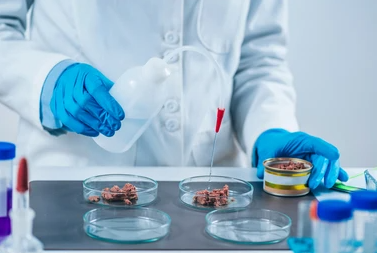Veterinary Drug Residue
The Hazards of Veterinary Drug Residues in Food
Veterinary drug residues can be divided into anthelmintics, growth promoters, tranquilizers, β-adrenergic receptor blockers, and other residues. Veterinary drug residues in foods of animal origin have gradually become a focus of attention worldwide. For animals, long-term use of antibiotics will produce drug-resistant strains, intestinal flora imbalance, and other hazards, which severely restrict the healthy and sustainable development of animal husbandry. For humans, long-term consumption of contaminated food will cause a variety of toxic reactions to the human body, transfer antibiotic-resistant bacteria to humans, allergic reactions, immunopathological effects, and "three causes" effects (research has found that many drugs are carcinogenic and teratogenic, mutagenicity). Regarding the environment, some drugs with stable properties can still exist stably after being excreted into the environment after being administered to animals, resulting in drug residues in the environment and severe damage to the ecological environment.
The Necessity of Detecting Veterinary Drug Residues in Food by ELISA

Due to the huge harm caused by veterinary drug residues, the World Health Organization (WHO) and other countries have explicitly banned the use of certain drugs in the animal breeding industry. Veterinary drugs play a very important role in preventing and treating animal diseases, improving production efficiency, and improving the quality of livestock products. However, the illegal use and abuse of drugs cause residues of veterinary drugs in animal-derived foods, which not only cause direct harm to human health but also cause great harm to the animal husbandry and the ecological environment. It is very necessary to conduct veterinary drug residue testing before food enters the market. ELISA with high specificity, high sensitivity, simplicity, and low cost has been favored in the detection of veterinary drug residues.
The Common Types of Veterinary Drug Residues That Can Be Detected by ELISA
Veterinary drugs that are more likely to cause excessive veterinary drug residues in animal-derived foods are mainly antibiotics, sulfonamides, furans, and other drugs.
Quinolones antibiotics are widely used in animal husbandry, aquaculture, and other aquaculture industries, including chickens, ducks, geese, chickens, ducks, geese, it is used for disease control in the breeding of pigs, cattle, sheep, fish, shrimps, crabs, etc. Human long-term consumption of animal food with quinolones residues can easily induce the transmission of drug resistance, thereby affecting the clinical efficacy of such drugs.
Tetracyclines as broad-spectrum antibacterial drugs have a wide range of applications in aquaculture, livestock breeding, and other industries. In addition, tetracyclines will also be used as feed and fertilizer additives to increase the antibody performance of animals and plants. Long-term consumption of foods contaminated with tetracyclines will lead to an increase in drug-resistant bacteria in the human body and toxic reactions. Chloramphenicol may cause aplastic anemia and produce "three causes" effects. Tetracyclines can also inhibit the growth and development of bones and teeth.
Nitrofurans are mainly used to treat urinary tract infections, intestinal bacterial infections, skin wound infections and as food additives to prevent poultry intestinal infectious diseases. However, these drugs are more toxic and may cause neurological toxicity and clinical symptoms of mental disorders. Studies have found that nitro heterocyclic compounds have cell mutagenicity and animal carcinogenic toxicity. The US Food and Drug Administration (FDA) and the European Medicines Agency (EMA) have banned its use in humans and animals.
The Advantages of Using ELISA to Detect Biotoxins in Food
- Can inhibit the production of drug-resistant bacteria from the source
- Can reduce the harm caused by contaminated food to humans
- Can promote the sustainable development of the animal breeding industry
Creative Diagnostics has been committed to the research of detecting veterinary drug residues in food. We provide reliable ELISA kits to detect veterinary drug residues. Supported by rich related R&D experience and diversified ELISA kits, we provide high-quality customized ELISA kits services, professional ELISA testing services, and believable ELISA development services related to veterinary drug residues. If you wish a lot of careful data, please contact us.
References
- Bacanlı, M.; Başaran, N. Importance of antibiotic residues in animal food. Food Chem Toxicol. 2019, 125: 462-466.
- Zhang, Z.; Cheng, H. Recent Development in Sample Preparation and Analytical Techniques for Determination of Quinolone Residues in Food Products. Crit Rev Anal Chem. 2017, 47(3): 223-250.
- Berends, B.R.; et al. Human health hazards associated with the administration of antimicrobials to slaughter animals. Part I. An assessment of the risks of residues of tetracyclines in pork. Vet Q. 2001, 23(1): 2-10.
- McCracken, R.J.; et al. Transfer of nitrofuran residues from parent broiler breeder chickens to broiler progeny. Br Poult Sci. 2005, 46(3): 287-292.
